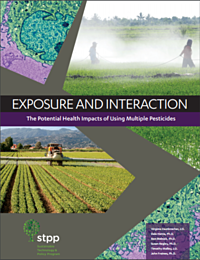 Multiple pesticides are used heavily in conventional agricultural practices where each chemical has a specific target pest. Applying pesticides together saves time and money, but it is unclear what health effects combining pesticides might have on farmers, their families and local communities, and for public health in general. Pesticide assessment is largely done on a chemical by chemical basis and does not assess the potential interactive impacts of these chemicals.
Multiple pesticides are used heavily in conventional agricultural practices where each chemical has a specific target pest. Applying pesticides together saves time and money, but it is unclear what health effects combining pesticides might have on farmers, their families and local communities, and for public health in general. Pesticide assessment is largely done on a chemical by chemical basis and does not assess the potential interactive impacts of these chemicals.
To fill this gap in knowledge, a report released earlier this year evaluates the possible cumulative health effects of three common pesticides used in the State of California. Developed through a collaboration between UCLA’s Sustainable Technology & Policy Program, the Pesticide Research Institute, Clark University, and Melnick Consulting, this report examines the state of the science on interactive effects of pesticide mixtures on human health and makes recommendations for their evaluation and regulation.
On this call, speakers discussed the development of this report, its recommendations, and the implications it has for policy. Dr. Dale Hattis provided an overview of the report and spoke specifically to the toxicological methodology involved in the assessment. Dr. Tim Malloy then highlighted the report’s recommendations to improve regulatory policies to better protect public health.
Featured Speakers
 Dale Hattis, PhD, is a Professor on the faculty of Clark University in the George Perkins Marsh Institute. He has served as a member of the National Toxicology Program Board of Scientific Counselors, on the Environmental Health Committee of the EPA Science Advisory Board, on the Food Quality Protection Act Science Review Board, and as a counselor and fellow of the Society for Risk Analysis. Dr. Hattis received the Society for Risk Analysis’s distinguished Educator Award and the Lifetime Achievement Award from the American Environmental Health and Science Foundation. He is also the past Chair of the Society for Risk Analysis Dose-Response Specialty Group. With over 245 publications and 42 years of experience in the development and application in methodology to assess health, ecology, and economic impacts of regulatory actions, his work has informed risk assessment on both cancerous and non-cancerous health endpoints. Dr. Hattis received his doctorate in genetics from Stanford University.
Dale Hattis, PhD, is a Professor on the faculty of Clark University in the George Perkins Marsh Institute. He has served as a member of the National Toxicology Program Board of Scientific Counselors, on the Environmental Health Committee of the EPA Science Advisory Board, on the Food Quality Protection Act Science Review Board, and as a counselor and fellow of the Society for Risk Analysis. Dr. Hattis received the Society for Risk Analysis’s distinguished Educator Award and the Lifetime Achievement Award from the American Environmental Health and Science Foundation. He is also the past Chair of the Society for Risk Analysis Dose-Response Specialty Group. With over 245 publications and 42 years of experience in the development and application in methodology to assess health, ecology, and economic impacts of regulatory actions, his work has informed risk assessment on both cancerous and non-cancerous health endpoints. Dr. Hattis received his doctorate in genetics from Stanford University.
 Tim Malloy, JD, is a Law Professor at the University of California Los Angeles (UCLA) and is Faculty Director of the interdisciplinary UCLA Sustainable Technology and Policy Program. After receiving his law degree, Professor Malloy clerked for Judge Donald W. VanArtsdalen of the U.S. District Court for the Eastern District of Pennsylvania. He joined the UCLA faculty in 1998, after spending a combined 11 years in practice at private firms and at the United States Environmental Protection Agency, Region III. Professor Malloy's research interests focus on environmental, chemical and nanotechnology policy, regulatory policy, and organizational theory and decision analysis, with particular emphasis on the relationship between regulatory design and implementation and the structure of business organizations. In addition, he has worked and written extensively in the area of risk governance and prevention-based regulation, melding together his academic interests with his work in the Sustainable Technology Policy Program.
Tim Malloy, JD, is a Law Professor at the University of California Los Angeles (UCLA) and is Faculty Director of the interdisciplinary UCLA Sustainable Technology and Policy Program. After receiving his law degree, Professor Malloy clerked for Judge Donald W. VanArtsdalen of the U.S. District Court for the Eastern District of Pennsylvania. He joined the UCLA faculty in 1998, after spending a combined 11 years in practice at private firms and at the United States Environmental Protection Agency, Region III. Professor Malloy's research interests focus on environmental, chemical and nanotechnology policy, regulatory policy, and organizational theory and decision analysis, with particular emphasis on the relationship between regulatory design and implementation and the structure of business organizations. In addition, he has worked and written extensively in the area of risk governance and prevention-based regulation, melding together his academic interests with his work in the Sustainable Technology Policy Program.
The call was moderated by Elise Miller, MEd, CHE's director. The call lasted for one hour and was recorded for archival purposes.
